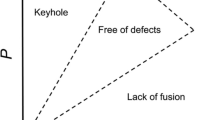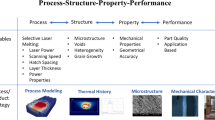Abstract
Directed energy deposition (DED) is an additive manufacturing (AM) technology that builds components using laser melting and solidification. To manufacture components with a consistent microstructure, powder feeding mechanism in the DED process must be precisely managed. Powder flow is one of the crucial determinants contributing to the quality of DED component produced. Considering this, research in powder feeders becomes critical. The rate of mass flow of powder elements in a rotary vane feeder is explored in this work utilizing mathematical, computational, and experimental methods. In mathematical model, the rate of mass flow was computed using volume and particle-based approaches. The discrete-element method (DEM) was used to simulate particle flow in rotary vane feeder. The effect of rotor speed on mass flow rate (MFR) is evaluated experimentally for aluminum, iron, and lead in order to explore the effect of particle density in powder flow characteristics. The experiment is also replicated with three variants of lead particle sizes to infer more on the impact of particle diameter on rate of mass flow. The accuracy of the mathematical model is assessed by comparing the experimental results to the mathematical and simulation results. In volume-based approach, the results showed that the simulated outcomes were 77% accurate to the experimental results. In particle-based approach, the results showed that the simulated outcomes were 93% accurate to the experimental results. The simulated result of mass flow rate is approximately 92% accurate in comparison to experiments. Further, in determining mass flow rate, the particle-based approach is more accurate than the volume-based approach. The findings of this research contribute to the development of a precise powder feeder in metal additive laser manufacturing (MALM), which finds use in modern manufacturing.















Similar content being viewed by others
References
Shi Y, Yan C, Zhou Y et al (2021) Overview of additive manufacturing technology and materials. Materials for additive manufacturing. Elsevier, Amsterdam, pp 1–8
Haley JC, Zheng B, Bertoli US et al (2019) Working distance passive stability in laser directed energy deposition additive manufacturing. Mater Des 161:86–94. https://doi.org/10.1016/j.matdes.2018.11.021
Altıparmak SC, Yardley VA, Shi Z, Lin J (2021) Challenges in additive manufacturing of high-strength aluminium alloys and current developments in hybrid additive manufacturing. Int J Lightweight Mater Manuf 4:246–261. https://doi.org/10.1016/j.ijlmm.2020.12.004
DebRoy T, Mukherjee T, Milewski JO et al (2019) Scientific, technological and economic issues in metal printing and their solutions. Nat Mater 18:1026–1032. https://doi.org/10.1038/s41563-019-0408-2
Wu J, Zhao P, Wei H et al (2018) Development of powder distribution model of discontinuous coaxial powder stream in laser direct metal deposition. Powder Technol 340:449–458. https://doi.org/10.1016/j.powtec.2018.09.032
Shishkovsky I, Missemer F, Smurov I (2012) Direct metal deposition of functional graded structures in ti- Al system. Phys Procedia 39:382–391. https://doi.org/10.1016/j.phpro.2012.10.052
Anderson R, Terrell J, Schneider J et al (2019) Characteristics of bi-metallic interfaces formed during direct energy deposition additive manufacturing processing. Metall Mater Trans B 50:1921–1930. https://doi.org/10.1007/s11663-019-01612-1
Kumar SP, Elangovan S, Mohanraj R, Srihari B (2021) Critical review of off-axial nozzle and coaxial nozzle for powder metal deposition. Mater Today. https://doi.org/10.1016/j.matpr.2021.03.037
Ahn D-G (2021) Directed energy deposition (DED) process: state of the art. Int J Precis Eng Manuf-Green Technol 8:703–742. https://doi.org/10.1007/s40684-020-00302-7
Dong F, Li Y (2020) Parameter simulation and analysis of rotary feeder. IOP Conf Ser Mater Sci Eng 772:012105. https://doi.org/10.1088/1757-899x/772/1/012105
Zhao J, Xu Y, Li J, Han L (2019) Experimental evaluation of steel particle conveying characteristics in a rotary vane feeder under high pressure. Powder Technol 351:122–133. https://doi.org/10.1016/j.powtec.2019.04.011
Gao W, Zhang Y, Ramanujan D et al (2015) The status, challenges, and future of additive manufacturing in engineering. Comput Aided Des 69:65–89. https://doi.org/10.1016/j.cad.2015.04.001
Thayalan V, Landers RG (2006) Regulation of powder mass flow rate in gravity-fed powder feeder systems. J Manuf Process 8:121–132. https://doi.org/10.1016/s1526-6125(06)80007-1
Arrizubieta JI, Wegener M, Arntz K et al (2016) Powder flux regulation in the laser material deposition process. Phys Procedia 83:743–751. https://doi.org/10.1016/j.phpro.2016.08.076
Ruan J, Tang L, Sparks TE, et al (2008) Direct 3D layer metal deposition and toolpath generation. In: Volume 1: 34th Design Automation Conference, Parts A and B. ASMEDC
Caiazzo F, Caggiano A (2018) Laser direct metal deposition of 2024 Al alloy: trace geometry prediction via machine learning. Materials (Basel) 11:444. https://doi.org/10.3390/ma11030444
Yan J, Battiato I, Fadel GM (2017) A mathematical model-based optimization method for direct metal deposition of multimaterials. J Manuf Sci Eng 139:081011. https://doi.org/10.1115/1.4036424
Angelastro A, Campanelli SL, Casalino G et al (2011) A methodology for optimization of the direct laser metal deposition process. Key Eng Mater 473:75–82. https://doi.org/10.4028/www.scientific.net/kem.473.75
Tang L, Landers RG (2011) Layer-to-layer height control for laser metal deposition process. J Manuf Sci Eng 133:021009. https://doi.org/10.1115/1.4003691
Al-Din N, Gunn DJ (1983) Metering of solids by a rotary valve feeder. Powder Technol 36:25–31. https://doi.org/10.1016/0032-5910(83)80005-9
Bhalode P, Ierapetritou M (2020) Discrete element modeling for continuous powder feeding operation: calibration and system analysis. Int J Pharm 585:119427. https://doi.org/10.1016/j.ijpharm.2020.119427
Gundogdu MY (2004) Design improvements on rotary valve particle feeders used for obtaining suspended airflows. Powder Technol 139:76–80. https://doi.org/10.1016/j.powtec.2003.10.010
Zhou H, Yang Y, Wang D et al (2022) Powder flow simulation of a ring-type coaxial nozzle and cladding experiment in laser metal deposition. Int J Adv Manuf Technol 120:8389–8400. https://doi.org/10.1007/s00170-022-09175-3
Alves JA, Silva RHGE, Dutra JC (2015) Development of a powder-feed device and procedures for the application of an experimental alloy in overhead PTA-P welding. Soldagem Inspecao 20:412–422. https://doi.org/10.1590/0104-9224/si2004.08
Balu P, Leggett P, Kovacevic R (2012) Parametric study on a coaxial multi-material powder flow in laser-based powder deposition process. J Mater Process Technol 212:1598–1610. https://doi.org/10.1016/j.jmatprotec.2012.02.020
Artaza T, Ramiro P, Ortiz M et al (2019) Effects of the nozzle tip clogging and the scanning direction on the deposition process during laser metal deposition of alloy 718 using a four-stream discrete nozzle. Procedia Manuf 41:264–271. https://doi.org/10.1016/j.promfg.2019.07.055
Liu W, Wei H, Huang C et al (2019) Energy efficiency evaluation of metal laser direct deposition based on process characteristics and empirical modeling. Int J Adv Manuf Technol 102:901–913. https://doi.org/10.1007/s00170-018-03220-w
Zhang J, Yang L, Li Z et al (2021) Transport phenomenon, flow field, and deposition forming of metal powder in the laser direct deposition with designed nozzle. Int J Adv Manuf Technol 114:1373–1383. https://doi.org/10.1007/s00170-021-06913-x
Jardon Z, Guillaume P, Ertveldt J et al (2020) Offline powder-gas nozzle jet characterization for coaxial laser-based directed energy deposition. Procedia CIRP 94:281–287. https://doi.org/10.1016/j.procir.2020.09.053
Bernhard R, Neef P, Eismann T et al (2020) Additive manufacturing of LMD nozzles for multi-material processing. Procedia CIRP 94:336–340. https://doi.org/10.1016/j.procir.2020.09.063
Shin J, Mazumder J (2018) Composition monitoring using plasma diagnostics during direct metal deposition (DMD) process. Opt Laser Technol 106:40–46. https://doi.org/10.1016/j.optlastec.2018.03.020
Hou QF, Dong KJ, Yu AB (2014) DEM study of the flow of cohesive particles in a screw feeder. Powder Technol 256:529–539. https://doi.org/10.1016/j.powtec.2014.01.062
Chhabra R, Basavaraj MG (2019) Particulate solids in bulk: Storage and flow. Coulson and Richardson’s Chemical Engineering. Elsevier, pp 67–132. https://doi.org/10.1016/C2014-0-01370-6
Durakovic B (2017) Design of experiments application, concepts, examples: state of the art. Period Eng Nat Sci (PEN). https://doi.org/10.21533/pen.v5i3.145
Lenth RV (2002) Experiments: planning, analysis, and parameter design optimization. J Am Stat Assoc 97:654–654. https://doi.org/10.1198/jasa.2002.s473
Rakić T, Kasagić-Vujanović I, Jovanović M et al (2014) Comparison of full factorial design, central composite design, and box-Behnken design in chromatographic method development for the determination of fluconazole and its impurities. Anal Lett 47:1334–1347. https://doi.org/10.1080/00032719.2013.867503
Antony J (2003) A systematic methodology for design of experiments. Design of experiments for engineers and scientists. Elsevier, Amsterdam, pp 29–43
Bhattacharya S (2021) Central composite design for response surface methodology and its application in pharmacy. Response surface methodology in engineering science. IntechOpen, London
Lee D-H, Jeong I-J, Kim K-J (2013) Methods and applications of dual response surface optimization: a literature review. J Korean Inst Ind Eng 39:342–350. https://doi.org/10.7232/jkiie.2013.39.5.342
Lin M-H, Tsai J-F, Yu C-S (2012) A review of deterministic optimization methods in engineering and management. Math Probl Eng 2012:1–15. https://doi.org/10.1155/2012/756023
Gopireddy SR, Hildebrandt C, Urbanetz NA (2016) Numerical simulation of powder flow in a pharmaceutical tablet press lab-scale gravity feeder. Powder Technol 302:309–327. https://doi.org/10.1016/j.powtec.2016.08.065
Leturia M, Benali M, Lagarde S et al (2014) Characterization of flow properties of cohesive powders: a comparative study of traditional and new testing methods. Powder Technol 253:406–423. https://doi.org/10.1016/j.powtec.2013.11.045
Rautiainen A, Stewart G, Poikolainen V, Sarkomaa P (1999) An experimental study of vertical pneumatic conveying. Powder Technol 104:139–150. https://doi.org/10.1016/s0032-5910(99)00056-x
Eshghinejadfard A, Hosseini SA, Thévenin D (2019) Effect of particle density in turbulent channel flows with resolved oblate spheroids. Comput Fluids 184:29–39. https://doi.org/10.1016/j.compfluid.2019.01.027
Fitzpatrick JJ, Barry K, Cerqueira PSM et al (2007) Effect of composition and storage conditions on the flowability of dairy powders. Int Dairy J 17:383–392. https://doi.org/10.1016/j.idairyj.2006.04.010
Bargieł M, Ford RA, Tory EM (2005) Simulation of sedimentation of polydisperse suspensions: a particle-based approach. AIChE J 51:2457–2468. https://doi.org/10.1002/aic.10517
Chen H, Jog MA, Evans DE, Turkevich LA (2021) Numerical investigation of powder aerosolization in a rotating drum apparatus. Powder Technol 390:62–72. https://doi.org/10.1016/j.powtec.2021.04.102
Wangchai S, Hastie DB, Wypych PW (2016) The investigation of particle flow mechanisms of bulk materials in dustiness testers. Part Sci Technol 34:241–254. https://doi.org/10.1080/02726351.2015.1069430
Pordanjani AH, Vahedi SM, Aghakhani S et al (2020) Multivariate optimization and sensitivity analyses of relevant parameters on efficiency of scraped surface heat exchanger. Appl Therm Eng 178:115445. https://doi.org/10.1016/j.applthermaleng.2020.115445
Tsolakis A (2006) Effects on particle size distribution from the diesel engine operating on RME-biodiesel with EGR. Energy Fuels 20:1418–1424. https://doi.org/10.1021/ef050385c
Melling A (1997) Tracer particles and seeding for particle image velocimetry. Meas Sci Technol 8:1406–1416. https://doi.org/10.1088/0957-0233/8/12/005
Atkins MD, Kienhöfer FW, Kim T (2019) Flow behavior in radial vane disk brake rotors at low rotational speeds. J Fluids Eng. https://doi.org/10.1115/1.4042470
Sorta AR, Sego DC, Wilson W (2012) Effect of thixotropy and segregation on centrifuge modelling. Int J Phys Model Geotech 12:143–161. https://doi.org/10.1680/ijpmg.12.00003
Acknowledgements
The authors acknowledge the DEM Solutions Limited, United Kingdom and Caezen Technologies, India for offering the support in analyzing the particle flow simulation.
Funding
The authors declare that no funds, grants, or other support was received during the preparation of this manuscript.
Author information
Authors and Affiliations
Contributions
SPK: experimentation, supervision, drafting, review and editing. JRR, SK: drafting and editing.
Corresponding author
Ethics declarations
Conflict of interest
The authors have no relevant financial or non-financial interests to disclose. All co-authors have seen and agreed with the contents of the manuscript and there is no financial interest to report. Authors also confirm that this research work is not funded by any University/Organization.
Additional information
Publisher's Note
Springer Nature remains neutral with regard to jurisdictional claims in published maps and institutional affiliations.
Rights and permissions
Springer Nature or its licensor (e.g. a society or other partner) holds exclusive rights to this article under a publishing agreement with the author(s) or other rightsholder(s); author self-archiving of the accepted manuscript version of this article is solely governed by the terms of such publishing agreement and applicable law.
About this article
Cite this article
Kumar, S.P., Ramakrishna, J.R. & Karthikeyan, S. Investigations on mass flow rate of rotary vane feeder for direct metal laser deposition. Prog Addit Manuf (2024). https://doi.org/10.1007/s40964-024-00602-3
Received:
Accepted:
Published:
DOI: https://doi.org/10.1007/s40964-024-00602-3




